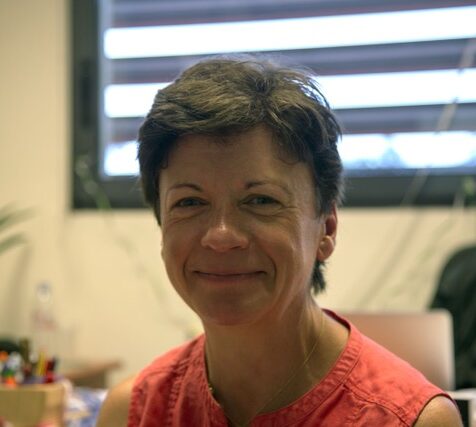Claude Grison: the formula for clean chemistry
She revolutionized chemistry by making it environmentally friendly. Claude Grison has just been awarded the 2022 European Inventor Award in the "Researchcategory by the European Patent Office . We look back at the career of the director of the ChimEco laboratory, for whom dialogue and transdisciplinarity are the keys to innovation.

Not strictly an ecologist, and not just a chemist, she defines herself as an " eco-chemist." " Chemistry and ecology are not radically different fields, but complementary ones. I work in both areas, which has allowed me to break down the barriers between these disciplines and come up with new ideas," explains Claude Grison.
For the woman who is now director of the Bio-Inspired Chemistry and Ecological Innovations Laboratory, interdisciplinarity is a necessity: " Our perspectives and knowledge are complementary." It was in 2007 that Claude Grison first became interested in ecology, thanks to the requests of four students in preparatory classes at Joffre High School: " They asked me for help with a project on pollution control using plants, and that's when I realized that certain plants could survive in hostile environments, on soil that was toxic to all other forms of life. Thanks to my teaching career, I changed my research activities! "
"Plant follies"
Intrigued and stimulated by this subject, which was not her field of expertise, Claude Grison immediately wanted to learn more about these "plant follies." So in 2008, the researcher joined the Center for Functional and Evolutionary Ecology . "I was the first chemist at CEFE," recalls Claude Grison. "Knowledge of ecology allows you to come up with new ideas in chemistry to create something new."
It was in this laboratory that she began working on plants that hyperaccumulate metallic elements. What makes them special? They extract polluting metals from the soil through their roots and accumulate them in their leaves. " For ecologists, the question is: 'Whyare these plants there? ' For chemists, it's 'How do they manage to live there? ' These two questions are complementary."
For the eco-chemist, a third question then arises: can this be useful? "We also need to ask ourselves what this work can bring to society, and consider the meaning we want to give to our research." And Claude Grison has found meaning. First, because his work makes it possible to effectively decontaminate soil and restore ecosystems that are sometimes severely degraded.
But that's just the tip of the iceberg... "I learned at that time that resources of certain metals were under threat and that soon there would be no more zinc, for example, even though it is an essential catalyst for many chemical reactions." This famous zinc that plants extract from the soil and which is found in their leaves... "What if these plants were the natural reservoir of zinc, the catalyst of tomorrow?" And even the ecocatalyst of tomorrow? A new concept was born. " And even a new chemistry, one that completely dispenses with toxic and polluting reagents or solvents, a truly ecological chemistry."
Catalytic effect
Very quickly, the results of her work began to bear fruit, and in 2009ADEME took notice of the researcher. "They wanted to offer me the Pollutec-Ademe Prize for Innovative Techniques for the Environment, but to do so, we first had to protect our work, and we hadn't filed a patent." In one week, a record time, it was done. "This first patent, followed by 35 others, marked a turning point in our research." And this Ademe award had a catalytic effect on the work of Claude Grison, who is developing the use of her hyperaccumulator plants not only in mainland France but also in New Caledonia, where the soil has a high concentration of nickel.
It was there, in the field, faced with industrial effluents contaminating rivers and ending up in the lagoon, that the researcher realized the importance of water pollution. What if these plant follies could also be used to clean up the water?
This issue was tackled head-on by the Bio-inspired Chemistry and Ecological Innovations Laboratory, founded in 2014. " Chemistry had become so important that we could no longer remain at CEFE, and that's how ChimEco was born." In 2016, researchers began treating aquatic systems with plants. " They have molecular antennae on the surface of their roots that capture metal elements." Claude Grison's team identified 40 species of plants with these unique properties, using whole, living plants to capture metals in water.
Restoring the environment
The experiment took on yet another dimension when Claude Grison and his team found a dead plant in their pollution control system. "Even though it was dead, it still had the same pollution control capacity!" The process then evolved: " Now we grind up roots to make plant filters that clean the water. " And not just any roots... The chemical ecologists use invasive species, which are real ecological disasters in wetlands. " Not only do we clean up pollution, but we also preserve the biodiversity of these areas , " emphasizes the specialist.
This revolutionary process has circular economy implications, as the substances extracted from water by plants are then used to produce plant-based catalysts that enable the production of various molecules needed in sectors such as the pharmaceutical industry. The start-up BioInspir, which now employs 10 people, was created in 2020 to promote these products. The company, born out of a desire to create a different kind of chemistry, is the only one in the world to have mastered this technology, which uses no chemical inputs, solvents, or synthetic reagents.
A new form of chemistry with no environmental footprint, which has earned Claude Grison the European Inventor Award 2022 in the "Researchcategory from the European Patent Office.
Discover Claude Grison's work in pictures in the latest issue of Lum magazine, dedicated to innovation.
